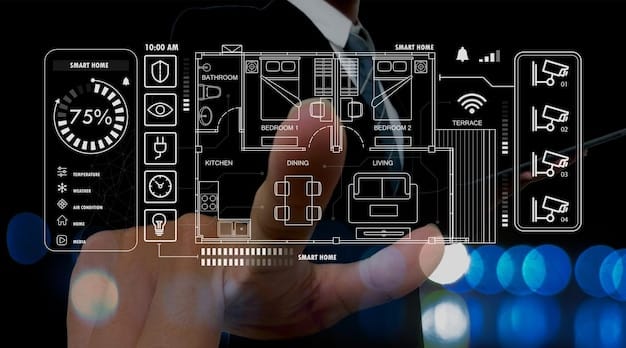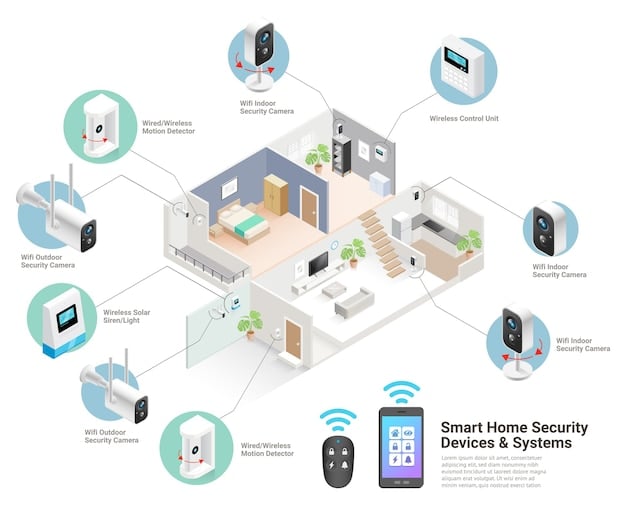Edge Computing in Smart Homes: Privacy Implications in 2025

Edge computing in smart homes shifts data processing locally, reducing reliance on the cloud and offering faster response times. By 2025, this trend could significantly enhance data privacy by minimizing data transmission and storage in centralized servers, though it introduces new challenges for securing distributed devices.
Navigating the evolving landscape of smart home technology requires a close look at how our data is handled. The rise of edge computing in smart homes: what does it mean for data privacy in 2025? is a question on many minds, as these technologies promise convenience but also raise valid concerns about our personal information being secure. Let’s explore this technological shift and consider it’s implications.
Understanding Edge Computing in Smart Homes
Edge computing moves data processing closer to the source, such as within your smart home. Rather than sending all information to a central cloud server, edge devices analyze and process data locally. This approach enhances speed and efficiency, but what are the broader implications for smart home technology?
In this section, we will delve into the nuts and bolts of edge computing to better understand its advantages.
What is Edge Computing?
Edge computing is a distributed computing paradigm that brings computation and data storage closer to the devices where it’s being gathered. In simpler terms, it’s about processing data at or near the edge of your network instead of relying on a central data center.
How Does it Work in Smart Homes?
Within a smart home, edge computing means that devices like smart speakers, thermostats, and security cameras can process data directly on the device or a local hub. This reduces latency, as data doesn’t need to travel to a remote server for analysis.
- Faster response times for smart home automations.
- Reduced bandwidth usage as less data is sent to the cloud.
- Enhanced privacy by keeping sensitive information on-premises.
Edge computing represents a fundamental shift in how smart homes operate, offering a more responsive and private user experience.
The Benefits of Edge Computing for Smart Homes
The adoption of edge computing in smart homes is driven by numerous advantages, ranging from improved performance to enhanced security. Let’s break down the key benefits and why they are increasingly relevant for homeowners.
Edge computing not only increases efficiency and speed but also supports user autonomy.

Increased Speed and Efficiency
One of the primary benefits of edge computing is the reduction in latency. Processing data locally means commands are executed almost instantaneously, making interactions with smart home devices feel more natural and responsive.
Enhanced Reliability
Edge computing enables smart homes to function even when the internet connection is unreliable or unavailable. Local processing ensures that critical functions, like security systems, continue to operate without interruption.
- Reduced reliance on cloud services, minimizing downtime.
- Improved energy efficiency by reducing data transmission.
- Support for real-time data analysis and decision-making.
These benefits highlight the potential of edge computing to transform the smart home experience, making it faster, more reliable, and more energy-efficient.
Data Privacy Concerns in Traditional Smart Homes
Traditional smart homes rely heavily on cloud-based processing, which raises significant privacy concerns. Understanding these issues is crucial for appreciating the potential of edge computing to enhance data protection.
Let’s discuss the privacy shortfalls with systems that depend largely on cloud computing.
Data Transmission Risks
When smart home devices send data to the cloud, it is vulnerable to interception. Hackers can exploit vulnerabilities in network connections or cloud infrastructure to gain access to sensitive information.
Centralized Data Storage
Storing data in centralized servers creates a single point of failure and a lucrative target for cyberattacks. A breach can expose the personal data of millions of users.
- Risk of unauthorized access and misuse of data.
- Compliance challenges with data privacy regulations like GDPR.
- Potential for data profiling and targeted advertising.
These concerns underscore the need for a more privacy-centric approach to smart home technology, which is where edge computing comes into play.
How Edge Computing Enhances Data Privacy
Edge computing offers a promising solution to many of the data privacy concerns associated with traditional smart homes. By processing data locally, it minimizes the need to transmit sensitive information to the cloud.
How does edge computing safeguard data, and how can we ensure these technologies put our privacy first?
Reducing Data Transmission
With edge computing, only necessary data summaries or insights are sent to the cloud, rather than raw data streams. This reduction in data transmission minimizes the risk of interception and exposure.
Decentralized Data Processing
Processing data locally means that sensitive information remains within the confines of the home network. This decentralized approach makes it more difficult for hackers to access and steal data.

- Enhanced control over personal data and how it is used.
- Reduced risk of data breaches and unauthorized access.
- Compliance with strict data privacy regulations.
Edge computing empowers users to take control of their data privacy, offering a more secure and transparent smart home experience.
Challenges and Considerations for Edge Privacy in 2025
While edge computing offers significant privacy benefits, it is not without its challenges. As we look to 2025, we must consider the potential pitfalls and how to address them to ensure privacy remains a top priority.
How can the privacy promises of edge computing be kept? Let’s examine the challenges we face.
Device Security
Securing edge devices themselves is critical. If a smart home device is compromised, hackers can gain access to the local network and potentially steal sensitive data. Therefore, strong authentication and regular security updates are essential.
Data Encryption
Even with local processing, some data may still need to be transmitted to the cloud for certain functions. Encrypting this data is crucial to protect it from unauthorized access during transit. Modern encryption techniques offer robust security without sacrificing performance.
- Ensuring devices are resistant to physical tampering.
- Implementing secure boot processes to prevent malware from running.
- Regularly patching vulnerabilities to address new threats.
Addressing these challenges is essential for realizing the full privacy potential of edge computing in smart homes. A multi-layered security approach that combines device protection, data encryption, and user awareness is key to future security.
The Future of Edge Computing and Smart Home Privacy
Looking ahead to 2025, edge computing is poised to become an integral part of smart home technology. As devices become more powerful and AI algorithms more sophisticated, edge-based processing will unlock new possibilities for privacy and personalization.
What trends and advancements can we expect to see in the near future?
AI-Driven Privacy
AI can play a crucial role in enhancing data privacy by detecting and mitigating threats in real-time. Edge-based AI algorithms can analyze data streams for suspicious activity and automatically adjust security settings to protect sensitive information.
Federated Learning
Federated learning enables smart home devices to collaboratively train AI models without sharing raw data. This approach allows for personalized experiences while preserving data privacy and security. Federated learning enables data sharing without the privacy risks.
- Increased adoption of privacy-enhancing technologies.
- Greater transparency in data handling practices.
- Empowerment of users to control their data and privacy settings.
The future of edge computing in smart homes is bright, offering a path toward greater privacy, security, and personalization. By embracing these advancements and addressing the associated challenges, we can unlock the full potential of smart home technology while protecting our personal information.
| Key Point | Brief Description |
|---|---|
| 🏠 Local Processing | Data is processed on-site, reducing cloud reliance. |
| 🔒 Enhanced Privacy | Less data transmitted to the cloud minimizes privacy risks. |
| 🚀 Faster Response | Local processing offers quicker reaction times. |
| 🛡️ Device Security | Securing devices is crucial for edge privacy. |
Frequently Asked Questions
▼
Edge computing is a distributed computing framework that brings data storage and computation closer to where it’s being gathered, rather than depending on a centralized data center.
▼
Edge computing enhances data privacy by processing data locally, minimizing the need to transmit sensitive information to the cloud, thereby reducing the risk of data interception and breaches.
▼
The main challenges include securing devices from tampering, implementing strong encryption, and addressing vulnerabilities through regular patching to protect user data effectively.
▼
AI enhances data privacy by detecting and mitigating threats in real-time, analyzing data streams for suspicious activity, and adjusting security settings to protect sensitive information proactively.
▼
Federated learning allows smart home devices to train AI models collaboratively without sharing raw data, enabling personalized experiences while preserving data privacy and security effectively.
Conclusion
As we move towards 2025, the integration of edge computing in smart homes represents a significant shift in data privacy. While challenges remain, the potential benefits of local data processing, enhanced by AI and federated learning, offer a promising future for secure and personalized smart home experiences. Embracing these advancements responsibly will be key to maintaining user trust and ensuring the long-term success of smart home technologies.





